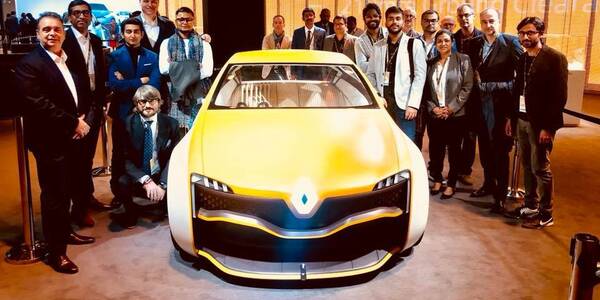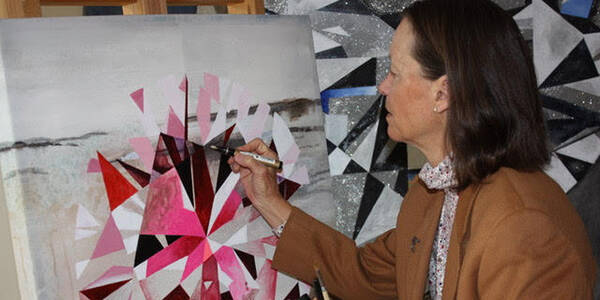profile / alumni / graphic-design
January 18, 2019
BY JAMIE WETHERBE
Avant Gardner: Meet Graphic/Motion Designer Tammy Szu
ArtCenter: What do you like most about your job?
Tammy Szu (BA 16 Graphic Design) freelance graphic designer/motion designer: I like that as a freelancer, I can take time off when I need it and turn inward and grow not only as a designer, but as a person. It’s kind of like meditation — but with my life instead of my body. A lot of people are overworked, which is extremely unhealthy. Or sometimes we just get so caught up with our work and social lives, that we get stuck in terms of personal growth because we don’t allow ourselves the time for much-needed self-reflection.
AC: What’s the one tool you can’t do without?
TS: I’ll be honest, I have really light eyebrows and I need to fill them in because I can’t go to work looking like the girl from The Exorcist. I need my eyebrow powder, pencil and brush.

I like that as a freelancer, I can take time off when I need it and turn inward and grow not only as a designer, but as a person.

AC: What’s the first site you look at when you open your computer in the morning?
TS: Gmail? And then maybe Instagram or Facebook? It’s not that interesting of an answer, but I don’t really follow any blogs…
I have this theory that, if you look at something, you’ll subconsciously end up using it in the future. So if you want your work to be unique, draw inspiration from sources outside of whatever it is you’re trying to do. Don’t dwell so much on what other people are doing. Be aware of what’s going on, but don’t obsess over things, just do you.
AC: Where do you go (online or offline) when you’re taking a break?
TS: If I’m at home, I’ll do a little bit of indoor gardening. I have about 70 houseplants, so I tend to my indoor garden like a 70-year-old retired grandma. If I don’t feel like being at home, I’ll just go work out.
AC: What do you do to detox from media and screens?
TS: My phone has been on silent for the past 5 years. I also periodically deactivate all my social media accounts. When you’re detoxing from something, you can’t just take that thing away without replacing it with something else — or you’ll end driving yourself insane. For a while, I replaced social media with gardening, then it became aerial arts classes, and now it’s actual working out — like barre, HIIT (high-intensity interval training) or lifting weights. I’m always doing something different.

AC: Describe a moment in your childhood where you first identified as a designer.
TS: I don’t think I identified as a designer until I was halfway through ArtCenter. I had no idea what I wanted to do with my life until my work got decent enough to where I actually wanted to share my work instead of hide it from prying eyes. There’s definitely a learning curve. And throughout that learning curve, you start to compare yourself to others, you start to doubt yourself and you ask yourself questions like, “Am I good enough? Is this what I should be doing with my life?” Some people never get past that learning curve and they just give up. So maybe it wasn’t for them.
AC: If you could have a superpower, what would it be?
TS: To teleport, so I don’t have to sit in traffic. I guess I could be like Nightcrawler from X-Men and save people, too…
AC: What’s your most prized possession?
TS: It’s a tie between my computer, my external hard drives and some of my hard-to-find plants. A few of my plants were imported from Colombia and Ecuador by the Pablo Escobar of the plant world…
AC: Where is your happy place?
TS: Studio fitness or dance classes are kind of my thing. I may be drenched in sweat and dying when I’m working out, but I always get home feeling so refreshed and I sleep like a baby at night.
Alumni Q&A
Submit the Alumni Q&A questionnaire to share your story. We want to hear about your accomplishments, what you're working on and your advice for future ArtCenter students.
AC: What’s your best piece of advice for an ArtCenter student who’s interested in following your career path?
TS: 1. Stay true to who you are as a person and if you don’t know what that means, then I suggest you take the time to find yourself.
2. All great designers have empathy and the ability to understand others by stepping into other people’s shoes. If you can’t genuinely understand what your clients’ wants and needs are, it’s going to show in your work.
3. Don’t be afraid to ask for things. You’d be amazed by the opportunities I came across and the people I’ve met and worked with by just growing some balls and sending an email to ask if they wanted to collaborate.
4. And lastly, NEVER let go of that childlike mindset. As adults, we think about consequences way too much, which holds us back. There’s a reason why children are far more creative than adults. They aren’t scared of being wrong, which makes them less afraid of experimentation, and ultimately leads to innovation.





